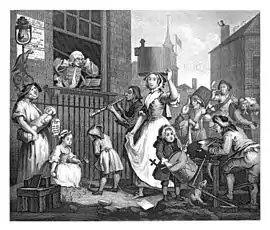Pietro Castrucci
Pietro Castrucci (1679 – 7 March 1752) was an Italian violinist and composer.

Castrucci was born in Rome, where he studied with Arcangelo Corelli; in 1715, he settled in London, where he became known as one of the finest virtuoso violinists of his generation. By 1718 he had become leader of the opera orchestra of George Frideric Handel, a position which he held until 1737, when he was succeeded by the younger John Clegg. In 1739 he became one of the first beneficiaries of the Royal Society of Musicians and was little heard of thereafter, apart from an erroneous report of his death in 1746.
After a benefit concert in Dublin in 1750,[1] he died there of malaria in 1752. Despite being by then a pauper, he was buried with full ceremony in St. Mary's Church, Dublin.
Castrucci was the inventor of the 'violetta marina', which was a variation of the viola d'amore. Handel wrote obbligati for this instrument.[2]
Works
- Sonate a Violino e Basso continuo, Op. 1
- Sonate a Violino e Basso continuo, Op. 2
- 12 Concerti grossi, Op. 3
- 12 Sonate a Flauto traverso o Violino o Hautbois e Basso continuo, 1731, published together with Francesco Geminiani
Notes
- Maxwell, Constantia (1997). Dublin under the Georges : 1714-1830. Dublin: Lambay Books. p. 125. ISBN 0708944973. OCLC 1244738727.
- Pratt, Waldo Selden. The History of Music. New York: G. Schirmer, Inc., 1907. page 303.
References
- Highfill, Philip H.; Burnim, Kalman A.; Langhans, Edward A. (1975), A Biographical Dictionary of Actors 1660-1800, Volume 3, Cabanel to Cory, SIU Press, pp. 104–105, 318, ISBN 0809306921
- Pietro Castrucci, Oxford Dictionary of National Biography, Oxford University Press, 2004.